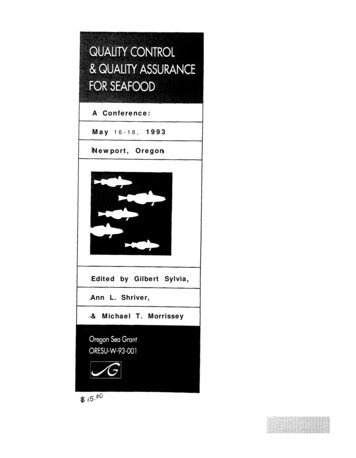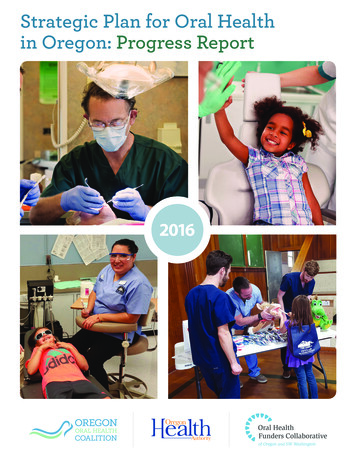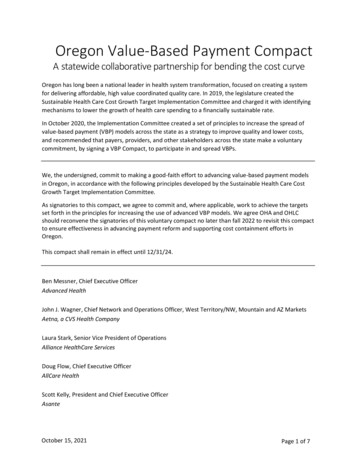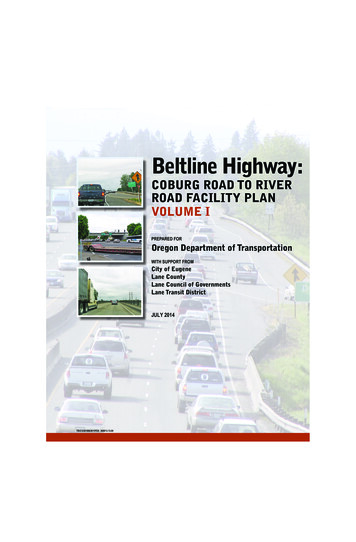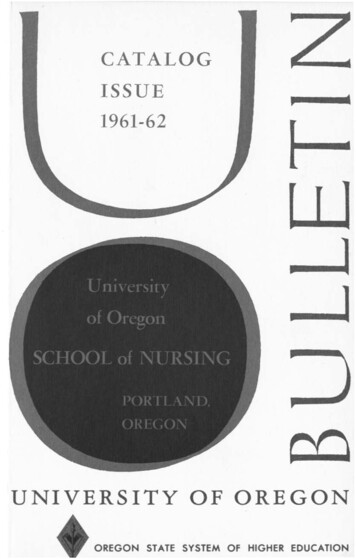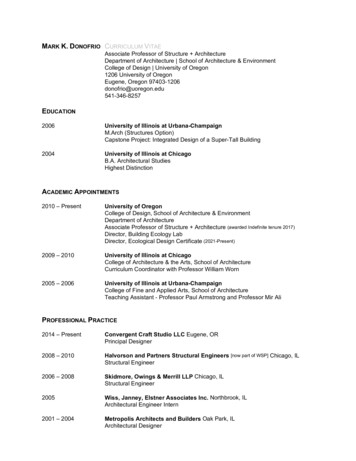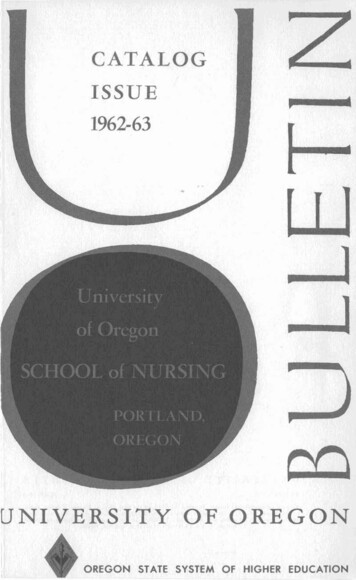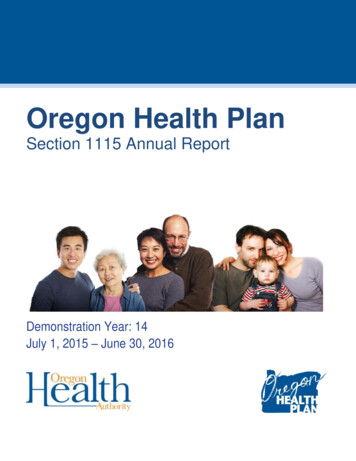
Transcription
Oregon Health PlanSection 1115 Annual ReportDemonstration Year: 14July 1, 2015 – June 30, 2016
Table of ContentsI. Introduction . 1A. Letter from the State Medicaid Director . 1B. Demonstration description . 2C. State contacts . 3II. Title . 4III. Overview . 4A. Overview of significant events across the state . 4B. Complaints and grievances . 5C. Appeals and hearings . 8D. 1 percent withhold and incentives . 9E. Statewide workforce development . 9F. Significant CCO/MCO network changes . 9G. Accomplishments: . 9Legislative activities . 17H. Litigation status . 17I. Quantitative and case study findings . 18IV. Utilization data. 21V. Evaluation activities and interim findings (Demonstration Year July 2015 – June 2016) . 21Table 9 - Evaluation activities and interim findings . 22VI. Metrics progress . 31A. CCO measure development and reporting . 31B. Hospital measure development and reporting . 33C. Committees and workgroups . 34D. Quality and access test . 34VII. Appendices . 35A. Enrollment reports . 35B. Neutrality reports . 36C. Two-percent trend reduction tracking . 36D. DSHP tracking . 36E. Oregon Measures Matrix . 36F. Hospital Transformation Performance Program (HTPP) data. 36
Oregon Health AuthorityG. Uncompensated Care Program . 36H. Transformation Center Flexible Services review and Learning Collaborative summaries . 362
Oregon Health AuthorityI. IntroductionA. Letter from the State Medicaid DirectorI am pleased to let you know about the Oregon Health Authority’s progress in meeting the goals of theOregon Health Plan (OHP) demonstration for the past demonstration year.Lever 1 - Improving care coordinationIn this demonstration year, the number of recognized PCPCH clinics in the state increased from 589 inquarter 2, 2015, to 629 in quarter 2, 2016. This surpasses Oregon’s goal of 500 clinics by 2015, andrepresents 60% of the estimated number of primary care clinics in Oregon.Lever 2 – Implementing alternate payment methodologies (APMs)In this demonstration year, the Federally Qualified Rural Health Center (FQHC) APM program found thatengagement touches among the cohorts steadily increased. It is estimated that, as the program becomesmore efficient and technical assistance for health centers will continue to improve. Clinical quality measures continue to maintain a consistent level, or improve significantly,demonstrating that detaching FQHC revenue from the office visit does not reduce quality. The actuarial consulting firm Optumas authored two reports showing significant reductions inemergency department and inpatient utilization for Phase 1 FQHC’s patient populations.Lever 3 – Integrating physical, behavioral and oral health careBehavioral Health - Five of the CCO incentive measures relate to physical and behavioral health careintegration. Measure specifications for three measures (Screening, Brief Intervention and Referral toTreatment (SBIRT), Follow-Up After Hospitalization for Mental Illness, and Mental, Physical, and DentalHealth Assessment Within 60 Days for Children in DHS Custody) changed in 2015. Generally, performanceon all measures increased over the demonstration year, with most exceeding their target benchmark. Pleasego to www.oregon.gov/oha/Metrics/Pages/HST-Reports.aspx for a full report on 2015 Health SystemsTransformation metrics.Oral Health - Since becoming OHA’s Dental Director in February 2015, Dr. Bruce Austin has been workingclosely with CCOs to integrate oral health services and align school based sealant programs with the CCOs.In 2015, the state added a dental sealant measure for kids to CCO metrics. Data from that year show that all16 CCOs improved in the percentage of students receiving a sealant during the measurement year, and thatthe statewide change increased by 65% over 2014. At the same time, oral health has become more fullyintegrated into coordinated care benefits. As of July 1, 2016, all 16 CCOs have integrated oral healthproviders and dental care organizations (DCOs) to provide care to their members.Lever 4 – Increased efficiency in providing careKey measures of efficient and effective care - such as Adolescent Well-Care Visits ( 17%), DevelopmentalScreening in the first 36 months of life ( 28%), Substance Abuse Screening and Treatment (SBIRT)( 98%) and effective contraceptive use ( 9%) - continued to improve. Please go px for a full report on 2015 Health SystemsTransformation metrics.The Oregon Health Authority’s Public Health Division’s Sustainable Relationships for Community Healthprogram awarded five grants to local consortia for Local Public Health Authorities (LPHA) to partner withJuly 1, 2015 to June 30, 2016Page 1
Oregon Health Plan Annual Reporttheir regional Coordinated Care Organizations (CCO) and local Community Self-Management Program (CSMP)organizations to align roles and responsibilities to improve health outcomes inprevention, early detection and self-management of chronic disease. All grantees developed plans andidentified quality improvement initiatives focusing on tobacco cessation referrals.Lever 5 – Implementation of health-related flexible servicesOHA’s evaluation contractor will include findings about the effectiveness of flexible services in its finalreport, which will be delivered by the end of 2017. In addition, the contractor will provide recommendationsfor evaluating flexible services following the end of the demonstration period. Indications of the usage andsuccess of Flexible Services were surveyed and reviewed by the Transformation Center in 2015, and asurvey summary reported the most commonly used Flexible Services as well as those that presentedchallenges. A Learning Collaborative of Flexible Services was subsequently held in October 2015. Pleasesee Attachment XXXX for summaries of these processes, including reports from specific CCOs.Lever 6 – Innovation through the Transformation Center:The Transformation Center continued to assess the implementation of the Community Advisory Councils’(CAC’s) Community Health Improvement Plans (CHIPs) in order to help guide the Transformation Center’ssupport of the CACs, which are key in developing the CHIPS.Lori CoynerState Medicaid DirectorB. Demonstration descriptionThe Oregon Health Plan (OHP) is the state’s demonstration project under Section 1115 of the SocialSecurity Act, funded through titles XIX and XXI of the Social Security Act.Phase I of OHP started on February 1, 1994, for Medicaid clients in the Poverty Level Medical (PLM) andAid to Families with Dependent Children (AFDC) populations. (AFDC is now known as TemporaryAssistance to Needy Families or TANF). One year later, Phase II added persons who are aged, blind, anddisabled, and it added children in state custody or foster care.Following the creation of the Title XXI Program in 1997, the State Children’s Health Insurance Program(SCHIP) was incorporated into OHP, providing SCHIP-eligible people with the same benefits and deliverysystem available to Medicaid clients.The OHP 2 demonstration began November 1, 2002.It established the OHP Plus and OHP Standard benefitpackages, and included the Family Health Insurance Assistance Program. In 2007 and 2009, more childrenbecame eligible when SCHIP eligibility was expanded and the Healthy Kids program was created.On July 5, 2012, the Centers for Medicare and Medicaid Services (CMS) approved the currentdemonstration, Oregon’s Health Care Transformation, through June 30, 2017. Key features include: Coordinated care organizations (CCOs): The state established CCOs as the delivery system forMedicaid and CHIP services. Flexibility in use of federal funds: The state can use Medicaid dollars for flexible services (e.g.,traditional health care workers), to be used for health-related care that is authorized under managedcare rules and regulations. CCOs will have broad flexibility in creating the array of servicesnecessary to improve care delivery and enrollee health.Page 2Demonstration Year 14
Oregon Health Authority Federal investment: The federal government agreed to provide federal financial participation (FFP)for several health care programs that previously had been supported entirely by state funds. Theseare called designated state health programs (DSHPs). DSHP spending is limited to 704 million FFPover the demonstration period July 5, 2012 through June 30, 2017. It is allocated by demonstrationyear (DY) as follows:DY111213Time 0/15FFP Limit 230 M 230 M 108 MDY1415Time Period07/1/15-06/30/1607/1/16-06/30/17FFP Limit 68 M 68 M Workforce: To support the new CCO model of care, Oregon agreed to establish a loan repaymentprogram for primary care providers who agree to work in rural or underserved communities inOregon, and training for 300 community health workers by 2015. As mandated by House Bill 3396(2015 Regular Session), Oregon will do further evaluation and research to determine how to bestrecruit and retain health care providers to practice in rural and medically underserved areas of thestate.The primary goals of the Oregon demonstration are: Improving health for all Oregonians: The state is committed to fostering innovative approaches toimproving population health through a focus on linking community health and services with theclinical delivery system. Population health efforts, Public Health Modernization and alignment withschools and the education system are integral to improving the health of all Oregonians by goingbeyond the walls of the clinics and hospitals. Improving health care: The state is working to coordinate physical, behavioral and oral health careand increase the focus on prevention and improved care. Individuals can get the care and servicesthey need, coordinated regionally with access to statewide resources when needed, by a team ofhealth professionals who understand their culture and speak their language. Reducing the growth in Medicaid spending: The state has agreed to reduce per capita medicaltrend, the growth in per capita spending, by 2 percentage points by the end of the second year of thedemonstration period from an assumed trend rate of 5.4 percent as calculated by federal Office ofManagement and Budget.In December 2013, conforming amendments for the Affordable Care Act and the full implementation of theTribal Uncompensated Care amendment to the 1115 Demonstration were approved.In June 2014, the Hospital Transformation Performance Program (HTPP) was approved, and OHA andCMS concluded final negotiations regarding the measures included in the program in September 2014. Thistwo-year program will offer hospitals incentive payments to support quality improvement.C. State contactsDemonstration Quarterly ReportsJanna Starr, Operations and Policy Analyst503-947-1193 phone503-373-7689 faxState PlanJesse Anderson, State Plan Manager503-945-6958 phoneJuly 1, 2015 to June 30, 2016Page 3
Oregon Health Plan Annual Report503-947-1119 faxCoordinated Care OrganizationsRhonda Busek, Provider Services Director503-945-6552 phone503-373-7689 faxQuality Assurance and ImprovementChris Norman, Compliance and Regulations Director503-945-7818 phone503-945-6548 faxFor mail delivery, use the following addressOregon Health AuthorityHealth Policy and Analytics500 Summer Street NE, E54Salem, OR 97301-1077II. TitleOregon Health Plan Section 1115 Annual ReportDemonstration Year (DY): 14 (July 1, 2015 – June 30, 2016)III. OverviewA. Overview of significant events across the stateCategory of eventA. Enrollment progressB. BenefitsC. CCO Complaints and GrievancesD. Quality of care – CCO / MCO / FFSE. AccessF. Provider WorkforceG. CCO ariesDemonstrationgoalsImpact? (Yes/No)Interventions or actions taken?(Yes/No)NoNoNoNoNoDetails on impacts or interventionsNothing to report.Page 4Demonstration Year 14
Oregon Health AuthorityB. Complaints and grievancesThe information provided is a compilation of data from the 16 coordinated care organizations. Thereporting period covers the quarters beginning 07/01/2015 and ending 06/30/2016. The chart shows theindividual line items that are required under each main category. The chart includes: The total of all complaints reported statewide by the 16 coordinated care organizations (CCOs) forthe quarter. Total number of statewide complaints that were pended at the end of the quarter, Average rate of enrollment during the quarter as reported by the CCOs, Rate per enrollee, which is based on the average total enrollment and calculated per 1000 members.Looking at the trends over the four quarters for all CCOs, shows the rate per 1000 members fluctuated fromthe lowest amount of 3.67 in the third quarter to 4.178 in the fourth quarter.The data shows the rate was higher in the last quarter of the reporting period. This is due to a change in theNon-Emergency Transportation contracts during the reporting period. As reported in the last two quarterlyreports, the CCOs are taking steps to reduce the rate of grievances received. Areas where the trend and rateis higher are seen in Access to Care and Interaction with Providers, or Plans.InterventionsWhile there has been an increased focus on tracking and reporting complaints, additional work internallywith OHA staff and processes as well as with the Plans is needed to improve reporting and trending analysisgoing forward.All categories of CCO complaints and grievances per quarterComplaint or grievance typeACCESS TO CAREa) Provider's office unresponsive, not available,difficult to contact for appointment or information.b) Plan unresponsive, not available, difficult tocontact for appointment or information.c) Provider's office too far away, not convenientd) Unable to schedule appointment in a timelymanner.e) Unable to be seen in a timely manner forurgent/emergent caref) Provider's office closed to new patients.g) Referral or 2nd opinion denied/refused byprovider.h) Referral or 2nd opinion denied/refused byplan.i) Provider not available to give necessary carej) Eligibility issuesk) Female or male provider preferred, but notavailablel) NEMT not provided, late pick up w/missedappointments, no coordination of servicesm) Dismissed by provider as a result of past duebilling issuesn) Dismissed by clinic as a result of past duebilling issuesACCESS TO CARE TOTAL:July 1, 2015 to June 30, 725899994Page 5
Oregon Health Plan Annual ReportComplaint or grievance typeINTERACTION WITH PROVIDER OR PLANa) Wants to change providers; provider not agood fit.b) Provider rude or inappropriate comments orbehaviorc) Plan rude or inappropriate comments orbehaviord) Provider explanation/instr.inadequate/incompletee) Plan explanation/instr. inadequate/incompletef) Wait too long in office before receiving careg) Member not treated with respect and dueconsideration for his/her dignity and privacyh) Provider's office or/and provider exhibitslanguage or cultural barriers or lack of culturalsensitivity, interpreter services not available.i) Plan's office or staff exhibits language orcultural barriers of lack of cultural sensitivity.j) Member has difficulty understanding providerdue to language or cultural barriers.k) Lack of communication and coordinationamong providers.l) Dismissed by provider (member misbehavior,missed appts. etc.)m) Dismissed by clinic (member misbehavior,missed appts. etc.)INTERACTION WITH PROVIDER OR PLANTOTAL:CONSUMER RIGHTSa) Provider's office has a physical barrierb) Concern over confidentiality.c) Client not involved with treatment plan.Member choices not reflected in treatment plan.Member disagrees with treatment plan.d) No choice of cliniciane) Fraud and financial abusef) Provider bias barrier (age, race, religion,sexual orientation, mental/physical health status)g) Complaint/appeal process not explained, lackof adequate or understandable NOAh) Not informed of consumer (Member) rightsi) Denied member access to medical recordsj) Did not respond to members request to amendinaccurate or incomplete information in themiddle record (includes right to submit astatement of disagreement)k) Advanced or Mental Health Directive notdiscussed, offered or followed.l) Be free from any form of restraint or seclusionused as a means of coercion, discipline,convenience or retaliation, as specified in otherFederal regulations on the use of restraints andseclusion. Restraint or seclusion used other thanto assure members immediate safety.Page tion Year 14
Oregon Health AuthorityComplaint or grievance typeDifferential treatment form Medicaid clientsCONSUMER RIGHTS TOTAL:QUALITY OF CAREa) Adverse outcome, complications,misdiagnosis or concern related to provider care.b) Testing/assessment insufficient, inadequate oromittedMedical record documentation issuec) Concern about prescriber or medication ormedication management issuesd) Member neglect or physical, mental orpsychological abusee) Unsanitary environment or equipmentf) Lack of appropriate individualized setting intreatmentQUALITY OF CARE TOTAL:QUALITY OF SERVICEa) Delay, quality of materials and supplies (DME)or dentalLack of access to ENCC for intensive carecoordination or case management servicesb) Lack of access to medical records or unableto make changesd) Benefits not 6141377144152321219718517225681070CLIENT BILLING ISSUESa) Co-paysb) Premiumsc) Billing OHP clients without a waiver15MiscellaneousCLIENT BILLING ISSUES TOTAL:Total complaints receivedTotal average CCO enrollmentRate per 1000 membersJuly 1, 2015 to June 30, 3594980,0423.673893931,5864.17814,554Page 7
Oregon Health Plan Annual ReportComplaints and grievances by category, SFY 2016C. Appeals and hearingsSee quarterly reports for the first, second, third and fourth quarters of the demonstration year.Page 8Demonstration Year 14
Oregon Health AuthorityD. 1 percent withhold and incentivesOHA analyzed encounter data received for completeness and accuracy for the subject months of July 2015through June 2016. All CCOs met the Administrative Performance (AP) standard for all subject months andno 1% withholds occurred.For incentives discussion, please refer to the 2015 Quality Pool.E. Statewide workforce developmentTraditional Health WorkersSee quarterly reports for the first, second, third and fourth quarters of the demonstration year.Health professional graduates participating in MedicaidSee quarterly reports for the first, second, third and fourth quarters of the demonstration year.F. Significant CCO/MCO network changesSee quarterly reports for the first, second, third and fourth quarters of the demonstration year.G. Accomplishments:Transformation CenterThe Transformation Center assists CCOs through Innovator Agents and CCO leadership, learningcollaboratives and technical assistance. Key highlights from this year:Transformation Center Strategic PlanHalfway through this year, the Transformation Center completed a strategic plan for initiatives to beimplemented during the remainder of the State Innovation Model grant (January through September 2016)and beyond. The plan includes the following focus areas: behavioral health integration, population healthintegration, value-based payment methods, CCO incentive metrics, health equity, clinical delivery supports,oral health integration and cross-cutting strategies. The plan reflects a shift toward providing targetedtechnical assistance, with the goals of responding to needs within CCOs, the Public Employees’ BenefitBoard and the Oregon Educators Benefit Board; and advancing integration of population and behavioralhealth. To inform this plan development, the Transformation Center reviewed a variety of data sources,consulted with multiple stakeholders and interviewed all 16 CCOs in December.Behavioral Health IntegrationThis year, the Transformation Center made progress on new initiatives to support behavioral healthintegration: The Patient-Centered Primary Care Institute created an online behavioral health integrationresource library, which is live at www.pcpci.org under “Resources.” The library includes fivevirtual site visits filmed at four integrated primary care practices and one behavioral health home.The website will also include videos of expert interviews focusing on topics such as behavioralhealth funding, psychiatry, substance use screening and treatment, and telehealth. This project wasinitiated based on a request from CCO and partner participants at last year’s Innovation Café. Behavioral health integration technical assistance consultation – The Transformation Center issupporting CCOs and their provider networks to implement their 2015-2017 Transformation PlansJuly 1, 2015 to June 30, 2016Page 9
Oregon Health Plan Annual Reportand achieve the integration standards established by the Patient-Centered Primary Care HomeStandards Advisory Committee. Each CCO can access up to 30 hours of behavioral and physicalhealth integration technical assistance. Staff met with 15 CCOs to discuss integration needs, and sofar 11 CCOs have been matched with appropriate consultants. Topic areas include trauma-informedcare; behavioral health homes; workflow; metrics; value-based payment models; screening, briefintervention and referral to treatment (SBIRT); and team development. Project ECHO (Extension for Community Healthcare Outcomes) – Project ECHO is anevidence-based tele-mentoring program that uses videoconferencing to connect primary careproviders with specialty providers. In September 2014, Health Share of Oregon and Oregon Healthand Science University (OHSU) launched Project ECHO in the Portland Metro region withTransformation Fund grant dollars from the Oregon Legislature. During that time, TransformationCenter staff participated in a multi-state training about tele-mentoring implementation and theProject ECHO in Medicaid Learning Collaborative organized by the Center for Health CareStrategies. In February, OHA released a solicitation ( 300,000 maximum) to establish a statewideProject ECHO tele-mentoring infrastructure with initial focus on psychiatric medicationmanagement. One proposal was received and accepted from OHSU focused on behavioral andmental health issues affecting children. The ECHO clinic has space for 20 practices, and 40 practicesrequested to participate. OHSU is selecting practices and exploring ways to include more.Population HealthCommunity Advisory Council SupportIn alignment with the Transformation Center’s new strategic focus on providing targeted technicalassistance, the Transformation Center is moving away from convening CCO community advisory councils(CACs) for monthly meetings on general topics and toward providing targeted support for CAC memberrecruitment and engagement.During this year, the Transformation Center convened multiple CAC subgroups and committees. The centercoto provide ongoing leadership development. The CAC steering committee was also convened several timesto advise the Transformation Center on how best to support community advisory councils statewide; discusshow CACs could get their community health improvement plan (CHP) topics incorporated into contractualagreements with their CCOs; and to make recommendations for the 2015 Coordinated Care Model Summit.CAC members were invited to the summit, and 114 CAC members attended. Several CAC members alsoparticipated in an OHA Accessibility Advisory Committee, which was convened to offer recommendationsfor ensuring accessibility at OHA events.With the guidance of a CAC recruitment and engagement committee, the Transformation Center led arecruitment and engagement-focused event for CAC leaders on May 24, 2016, in Eugene, Oregon.Objectives of this event included: Compiling a list of CAC member engagement strategies used by CCOs across the state Sharing and discussing materials used for outreach and recruitment Identifying CAC-specific recruitment goalsThe event brought together 63 participants from across the state, representing all 16 CCOs and 21 of the 36CACs. Event evaluation feedback was very positive overall and approximately 90 percent of respondentsreported the event was valuable in supporting their work.Page 10Demonstration Year 14
Oregon Health AuthorityIn addition, the Transformation Center contracted with Intersect Video to produce a 30-second publicservice announcement to support CCOs in recruiting and engaging Oregon Health Plan members in theirlocal CACs. A separate English and Spanish version was created for each CAC to use in their communities.Community Health Improvement Plan Implementation GrantsThe Transformation Center’s Community Health Improvement Plan (CHP) Implementation Grants wereannounced in January and all 16 CCOs submitted applications. The grants include up to 30,000 per CCO tosupport the implementation of strategies identified in their CHPs. Applications included activities such aschronic disease self-management, diabetes prevention, tobacco treatment specialist training, traumainformed care training, motivational interviewing training, community engagement and needs assessmentinitiatives, and health and early learning program expansions. An overview of all 16 grant projects isavailable on the Transformation Center website. The CCOs have until December 31, 2016, to complete theirgrant-funded activities, and the funds are meant to spark longer-term population health transformation at thecommunity level.By June 30, all 16 applicants moved toward grant executi
(SCHIP) was incorporated into OHP, providing SCHIP-eligible people with the same benefits and delivery system available to Medicaid clients. The OHP 2 demonstration began November 1, 2002.It established the OHP Plus and OHP Standard benefit packages, and included the Family Health Insurance Assistance Program. In 2007 and 2009, more children

